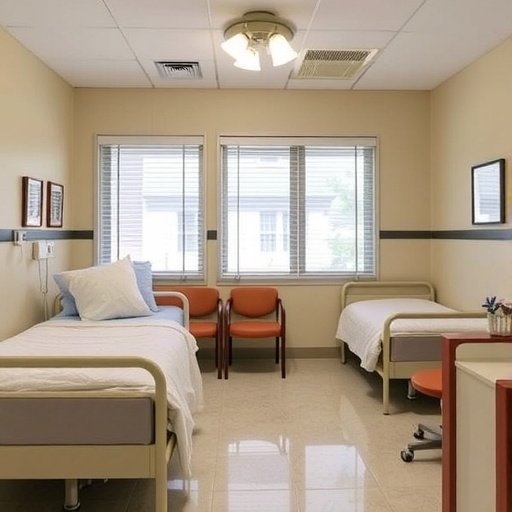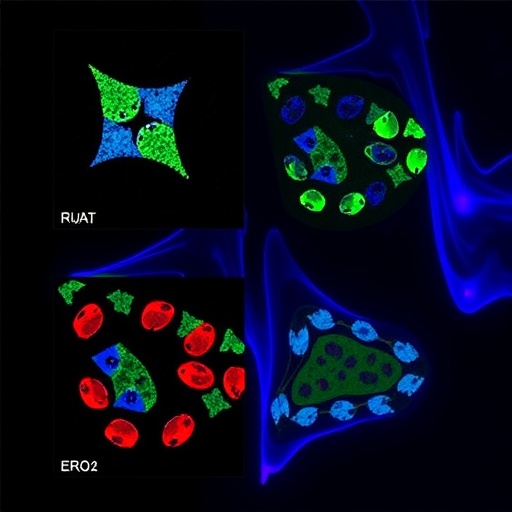In a groundbreaking investigation that could redefine care standards in neonatal and pediatric units, researchers led by Ottonello and a team of specialists have delved into the transformative impact of single-family rooms within intensive care settings. The study systematically reviews the multifaceted outcomes resulting from the implementation of these private accommodations, particularly focusing on newborns, young patients, their families, healthcare staff, and the overall organizational environment. This mixed-method systematic review provides compelling evidence that challenges traditional models of pediatric care, encouraging a shift towards more personalized and family-centered approaches.
Historically, intensive care units (ICUs) have been designed to optimize the monitoring and treatment of critically ill patients, often at the expense of familial support and a more nurturing environment. In contrast, the concept of single-family rooms in neonatal and pediatric ICUs represents a paradigm shift. These private spaces not only allow for closer interactions between parents and their children but also significantly improve the quality of care provided. The review underscores the importance of physical space in healthcare settings, illuminating how it affects both clinical outcomes and the emotional well-being of families under stress.
In examining the effects of the single-family room model, the study highlights a notable enhancement in parental involvement during critical moments. Families often find themselves in distressing circumstances when their child is admitted to an ICU. The traditional multi-bed arrangements can create feelings of isolation and anxiety, fundamentally affecting the psychological well-being of both parents and patients. In stark contrast, single-family rooms afford parents the opportunity to remain close to their child, foster stronger bonds, and engage more deeply in care processes—ultimately leading to better outcomes.
Furthermore, the results reveal significant improvements in patient recovery times and health outcomes. The single-family rooms allow healthcare providers to concentrate better on individual patient needs within a quieter and more controlled environment. This heightened degree of attention translates into more efficient care and potentially shorter ICU stays for young patients. The research identifies essential correlations between the physical layout of care environments and their impact on healing, providing evidence that supports the need for reconfiguration of standard ICU designs.
For healthcare personnel, the introduction of single-family rooms heralds a change not only in patient care but also in professional satisfaction and operational efficiency. Staff members report feeling more empowered and engaged when they can cultivate relationships with families in a more intimate setting, aiding in streamlined communication and collaborative decision-making. A nurturing atmosphere enhances teamwork, helping healthcare professionals to share critical information more effectively, thereby improving care delivery.
However, the review does not overlook the complexities that accompany such a shift. Implementing single-family rooms requires substantial investment and rethinking of existing infrastructure. Hospitals must be prepared to adapt their resources and logistical processes to accommodate this model. While initial costs and training may seem daunting, the evidence suggests that the long-term benefits—both in terms of health outcomes and financial implications for healthcare systems—can offset these challenges significantly.
In this study, the impact on organizational dynamics is also profoundly significant. Moving towards single-family rooms presents an opportunity for institutions to reformulate their leadership and operational strategies. Facilities that embrace these changes can cultivate environments that value the emotional and physical healing of both patients and families. The organizational culture, in turn, shifts toward one that prioritizes patient-centered care, reducing overall institutional strain and fostering a supportive workplace atmosphere.
The research anticipates that this transformative shift will have wide-ranging implications for policy. Healthcare policymakers must be keenly aware of the need for supportive regulations encouraging institutions to adopt single-family room configurations. By advocating for patient and family-centered care, legislation can promote sustainable healthcare practices and propel improvements across pediatric healthcare settings.
Moreover, the integration of technology can further enhance the experience of single-family rooms. Innovations in remote monitoring and patient engagement tools can assist healthcare professionals in maintaining high-quality care while still ensuring that families have the privacy and engagement they need. Technological advancements can bridge gaps, allowing for continuous connection between families and care teams, fostering a cohesive, integrated care experience.
Patient and familial perceptions are critical components of this narrative. Empowering families by including their voices within care processes profoundly impacts patient outcomes. The feelings of security and support experienced within a single-family room can lead to better compliance with treatment regimens and a greater understanding of care protocols. When families feel they are part of the healthcare team, the entire system benefits.
Engaging with this study not only allows for reflection on current practices but also provokes critical dialogue surrounding health equity. Ensuring all families have access to single-family room accommodations is imperative. The systemic disparities seen in healthcare necessitate a thrilling discussion about the equitable distribution of resources in hospitals, particularly those that can vastly improve outcomes in pediatric care.
As the field of pediatric medicine continues to evolve toward better models of care, the findings from this mixed-method systematic review serve as a beacon for practitioners, healthcare administrators, and policymakers alike. Advocates for patient-centered practices must embrace the implications presented in this research, pushing for a future where the emotional and physical needs of both patients and families are prioritized.
Ultimately, the evidence produced by Ottonello and collaborators advocates for a substantial paradigm shift. The principles of care reflect an understanding that healing transcends clinical measures and includes emotional, social, and familial dimensions. As healthcare leaders navigate this transformational journey, the study illuminates the path toward a future where the single-family room model becomes a standard bearer in pediatric care.
This mixed-method review undoubtedly lays a solid foundation for further research as well, prompting future studies to explore long-term impacts and cost-effectiveness or to investigate the nuances associated with specific patient demographics. The explorations of these areas will provide a comprehensive understanding of how best to utilize single-family rooms in pediatric care settings.
By embracing the complexities of family involvement and the nuances of healthcare delivery, institutions can ensure that their approaches honor every child’s journey through illness. The future of pediatric care hinges on the lessons learned through comprehensive studies like these, advocating for environments that support the critical interplay between family, patient, and healthcare provider.
Subject of Research: Impact of Single-Family Rooms in Neonatal and Pediatric ICUs
Article Title: The Effects of the Introduction of the Single-Family Room in Neonatal and Paediatric Intensive Care on the Outcomes of Paediatric Patients, Families, Staff, and Organizations: A Mixed Method Systematic Review
Article References:
Ottonello, G., Rossi, S., Dasso, N. et al. The effects of the introduction of the single-family room in neonatal and paediatric intensive care on the outcomes of paediatric patients, families, staff, and organizations: a mixed method systematic review. BMC Health Serv Res 25, 1407 (2025). https://doi.org/10.1186/s12913-025-13595-8
Image Credits: AI Generated
DOI: 10.1186/s12913-025-13595-8
Keywords: pediatric care, single-family room, neonatal intensive care, family-centered care, healthcare outcomes, patient satisfaction, healthcare policy, mixed-method research
Tags: critical care environment for familiesemotional well-being in healthcare settingsfamily-centered pediatric approacheshealthcare design and patient outcomesimpact of private accommodations in ICUsmixed-method systematic review in healthcareneonatal care improvementsoptimizing pediatric intensive care unitsoutcomes of single-family room modelparental involvement in child healthcaresingle-family rooms in pediatric caretransforming pediatric care standards





